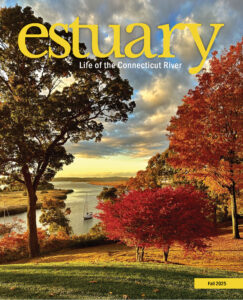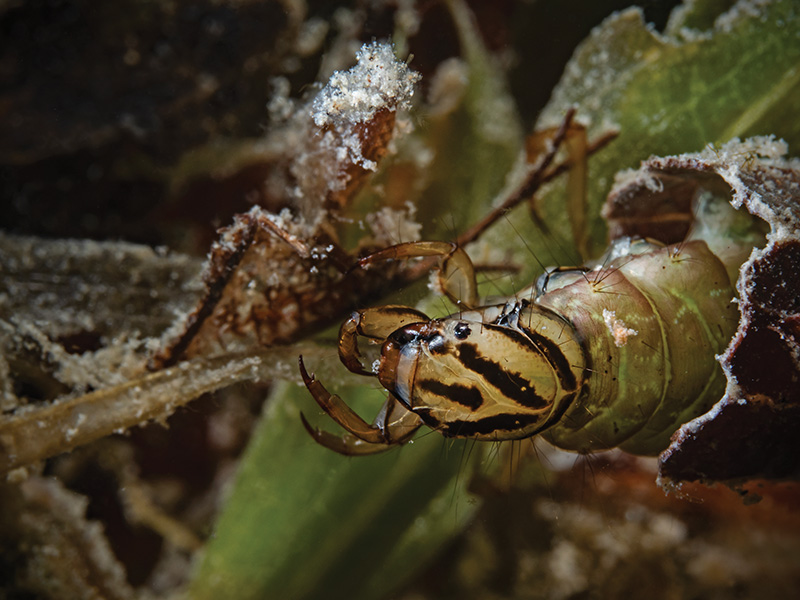 This article appears in the Fall 2025 issue
This article appears in the Fall 2025 issue

One of the many things we have learned over the decades working to make our rivers, streams, lakes, and wetlands healthy and full of life again is that some of the smallest and least conspicuous river critters can play an outsized role in this work.
Readers of this column may recall the piece on the algae species Cymbella back in 2023 and what this microscopic diatom tells scientists about river health. The caddisfly is another one of these clean water workers who have something to tell us.
The anglers among us may already be thinking ahead and guessing that what the caddisfly has to say is something like, “I know how to help you catch that brookie,” as a dry fly lure on the end of their line. True enough, angler friends. (See: Casting About, Summer 2025.)
But there’s a bigger and more powerful message coming from this taxonomic order (Trichoptera), the largest group of aquatic insects. While the caddisfly does go through a complete metamorphosis and eventually emerges as a terrestrial flying insect, its more interesting phases are the aquatic ones. The common defining attribute of the caddisfly is its ability to generate silk, and these hard-headed (literally), antenna-less critters are savvy and sophisticated home builders.

An adult caddisfly. Image Credit: Getty Images.
While these insects are small, it’s easy to see their home-building skills if you look closely in a small stream. The many different species of caddisfly have adapted to different aquatic habitats, so you can find them anywhere from still pools to quickly rushing riffles. In those quiet pools they will use their silk to construct homes from leaves or small sticks and twigs. One of the important jobs of the caddisfly is to help decompose organic matter in streams. Trichoptera shred organic material like leaves and twigs with their strong jaws as part of the freshwater nutrient cycling. To see them in pools, look for small collections of shredded leaves and twigs in a gossamer web of silk.
Where water is flowing faster over cobble and gravel bottoms you will find them nestled into tubular homes made of small stones with just their tough little noggin poking out the end! The critter has collected these stones and artfully built a snug, tubular home cemented together with its silk. You can find these sturdier homes by gently turning over rocks and seeing these small structures, usually less than an inch long, attached to the underside of the rock.
Most of the different species of caddisfly are sensitive to water quality conditions, particularly the amount of dissolved oxygen in the water. When the dissolved oxygen is low due to increased temperatures or too much nutrients in the water, they are not able to survive. This characteristic is used by aquatic scientists to monitor the health of rivers and streams in ways that are much more powerful than occasionally taking a measurement of dissolved oxygen with a meter or chemical test.
How so, you ask? For more than thirty years, scientists have been assembling groups of aquatic organisms—algae, bugs, and fish—and grouping them according to their tolerance for different conditions of pollution. Some river critters are very tolerant of low dissolved oxygen or turbidity or other chemical conditions, some are not. The caddisfly larvae are important members of these groupings of indicator species

A caddisfly larva underwater. Image Credit: Getty Images.
By creating these groupings based on extensive monitoring and statistical analysis, a robust predictive model is created and used to understand how our work to improve and protect water quality is doing. So if we watch which critters are living where, that can tell us if a stretch of river is getting healthier with much more certainty than a simple measurement of dissolved oxygen, turbidity, or pH.
Here’s to another clean water worker helping us all to enjoy what our rivers and streams give us all!
Andrew Fisk, PhD, is the Northeast Regional Director for American Rivers and a board member of The Watershed Fund. American Rivers is championing a national effort to protect and restore all rivers. Healthy rivers provide people and nature with clean, abundant water and natural habitat. For fifty years, American Rivers’s staff, supporters, and partners have shared a common belief: Life Depends on Rivers.
